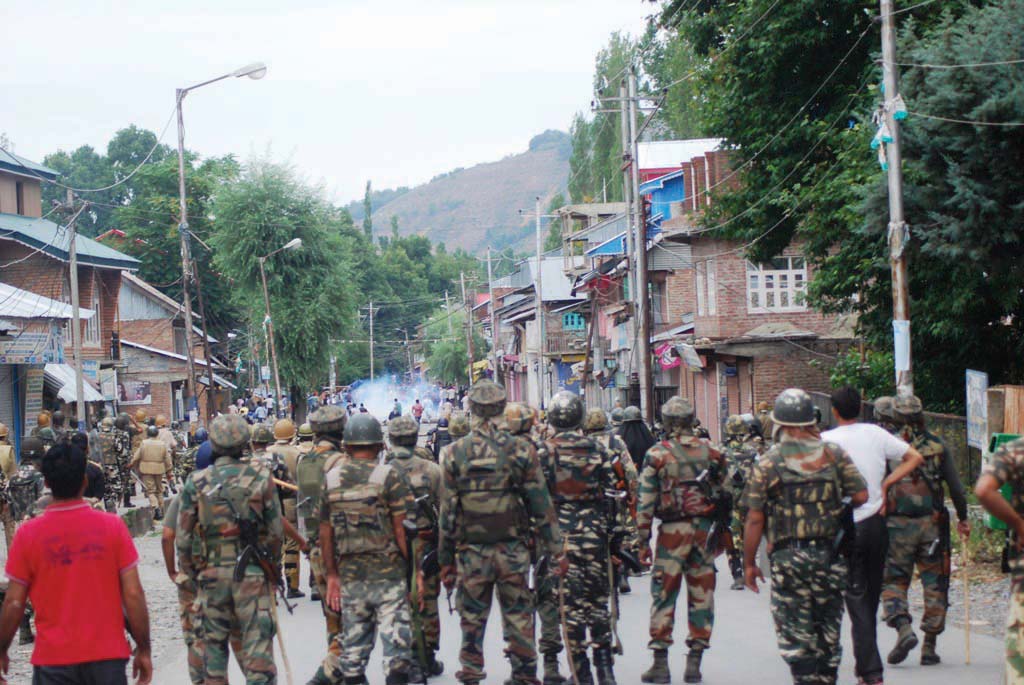By Khursheed Wani

During the early years of militancy in Kashmir, a security officer waylaid a senior journalist in Lal Chowk area and slapped him without any provocation. In response, the poor scribe said thank you to the officer and walked away without creating any scene. That was the time when army and paramilitaries were cordoning off habitations before the crack of dawn, announcing crack down from the mosque loudspeakers and directing all men to parade to nearby ground with a warning that anyone found inside his house during the searches would be shot.
Men, young and old, would come out, listen to the abuse of the soldiers and occasionally were getting hit with a rifle butt or a bamboo cane, especially if they did not walk the way soldier would like. For hours, these men were paraded before veiled informers or made to listen ‘sermons’ by an officer over the essence of peace, development or the hazards of supporting militants. During these shows of strength by counter-insurgency grid, people used to appear benign and surrendered. If someone did otherwise, like mustering courage to speak up, he would face the consequences. In my neighbourhood, a promising young man was brutally tortured because he dared to speak to an officer in chaste English. While he cried and wailed in the makeshift torture cell, nobody dared to speak for him. When he fell unconscious, profusely bleeding, the soldiers wrapped up the crackdown. Few days later he died in a Srinagar hospital.
Cut to 2017. The government forces cordon off a village in Kulgam or Bandipora on an input that militants are hiding there. This time villagers are not herded to a ground on gunpoint. The forces focus on the houses zeroed in on. But the village youngsters and hordes of them from the neighbourhood, attempt to break the cordon to help militants escape. They hurl stones at soldiers to disrupt their operation. During past several months, these youngsters helped several militants to escape. In a south Kashmir village, scores of youngsters hijacked a government-owned bus to travel to a village where siege was being laid to trap militants. They braved pellet showers but ensured the holed up militants escaped unscathed.
This is not an easy transformation of the situation. It tells volumes about the state of mind of the younger lot. It has thrown a bigger challenge to the government that was sitting pretty on the perpetual dwindle in the number of rebels and the incidents of violence. On the face of it, it is suicidal to hurl rocks on the armed forces during an operation but a large number of youngsters do indulging into it.
More intriguing is that attacking army during cordons is not a south Kashmir specific phenomenon. In Hajin, once a bastion of counterinsurgency and home to Kuka Parray who shook the separatist castle under the tutelage of army, now youngsters are braving bullets to save militants. In the past two months, they saved militants at least five times when they were almost caught.
On February 15, army chief Gen Bipin Rawat, spoke tersely on the phenomenon of common people helping out militants. A day before, four soldiers including a Major had been killed in two encounters and he directly blamed the ‘public support to militants’ for the higher casualties. “We are giving them (people) an opportunity, should they want to continue (to support militants), then we will continue with relentless operations, maybe with harsher measures and that is the way to continue,” Rawat said in Delhi. Minister of state in PMO Dr Jatinder Singh endorsed Rawat’s comments.
What could be the harsher methods? The people of Kashmir have seen the worst situations. The harsh methods could be indiscriminate use of pellet guns to blast out eyes and killing civilians in doves? But, it would be the repetition of a miserably failed experiment. It is bound to be counter-productive and more lethal than it is showing now.
The defiance at the encounter sites requires deep analysis of the situation. It reflects the hopelessness of Kashmiris who are now ready to prefer death if it comes out of some degree of ‘heroism’. They believe comforts and sweetness of life is missing. They also believe that last three decades of bloodletting has not taken them anywhere, not to even 1988.
A proper understanding of this situation can only lead to a tangible way-out. The harsh method was used in Sharshali village near Pampore during the public unrest last year that resulted into death of a college lecture. It only embarrassed the government. “Professional tacticians of the Army, CAPFs and Police must think through this tricky situation and find a solution that not only is flexible from point to point but also minimises the collateral damage of spiraling civil unrest,” wrote a Chandigarh based keen Kashmir watcher.
The harsher methods may once again force a journalist to say thank you to a brute officer after getting a slap but it cannot offset the dispassion each such act creates and intensifies inside the hearts and minds of Kashmiris.














